

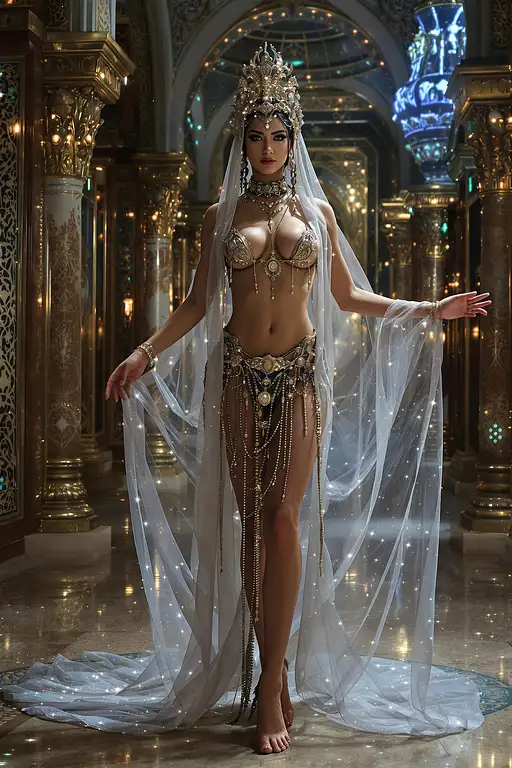
3 months ago
Full body view of A 19th-century masterpeice oil painting style depicting a belly dancer woman in revealing oriental-inspired clothing. She is adorned with translucent fabrics, metallic veils, and ornate chains that shimmer under ambient lighting. Barefoot. Her look is ethereal, with an abundance of piercings adding to her mysterious allure. The scene is set within an interior combining Persian architectural influences with a futuristic techno space design, featuring intricate patterns, glowing motifs, and surreal magical elements. The atmosphere is awe-inspiring, blending historical opulence with a futuristic mystique.

5 months ago
A stunning masterpiece of a Harley Quinn portrayal blending surreal elements and vibrant color with her seductive allure. She is wearing a deconstructed mini-skirt outfit with abstract shapes, with the colors seeming to flow with her form, set against a background with a subtle, gradient that seems to warp with the image. Her detailed photorealistic face features bold, manga-inspired makeup, with perfect eyes that seem to draw you into an alternate reality. The UHD picture is enhanced with a soft crystal translucency, creating a dreamlike and ethereal quality. With a dynamic and captivating pose, Harley’s appeal draws the viewer into her world of abstract beauty and playful chaos.

7 months ago
((("DARK PHOENIX")))Dark Fantasy steampunk character font text, page sketch, hand-painted, description in margins, Soulless, Shadowy Graffiti art, dark forest dystopian mural, Sketch, watercolor oil slick ink wash pearlescent tone overlay splash art pour, textured brushwork, water wash soulful, alien shrooms, glowing prismatic waves of neon light waves and streams of translucent faint luminous spectral fairy dust swirl through the scene. Dark-side Shadow-fiend, dark dystopian diseased necrotic Dark Phoenix rising wings spread in the background, perfect symmetry, long long long knee-length fiery ash flyaway hair streaming behind them, full-length creative random casual relaxed pose, clothed in a full-body funky skintight tie-dyed body hugging retro translucent flowing-multilayered elemental sheer gown with bits of holographic latent embers, transparent dead dying wildflowers trail behind her in the background, bold dark colour, introvert, dancing alone in the rain, steampunk Movie Poster art design by ((("wyldeairt")))

7 months ago
((("Dark Phoenix"))) gothic font text style, holographic foil quill paper art style, 3D, HDR Dark Fantasy steampunk character,free spirited Soul, Shadowy Graffiti art, dark forest dystopian mural, watercolor oil slick ink wash pearlescent tone overlay splash art pour, textured brushwork, water wash soulful, Dark-side Skeletal Shadow-fiend, dark dystopian, full-length hunched over, forlorn, kneeling head bowed dynamic pose, diseased necrotic Dark Phoenix rising wings spread perfect symmetry, long long long knee-length fiery ash flyaway hair streaming behind her, clothed in scorched ashen skintight body hugging retro translucent flowing-multilayered elemental sheer clothes with bits of holographic latent embers, transparent dead dying wildflowers trail behind her in the background, bold dark colour, introvert, dancing alone in the rain, retro steampunk Black Light Movie Poster art design by ((("wyldeairt")))

5 months ago
Wednesday Addams is depicted in a stunning, gothic deep plunging dress that features a high slit and intricate cut-outs, all adorned with delicate black lace. The dress is designed to accentuate her mysterious and alluring persona, with a high collar that adds an element of sophistication and elegance. The fabric of the dress is dark and eerie, perfectly matching her macabre personality. The dress hugs her slender frame, highlighting her pale, almost translucent skin, which contrasts sharply with the dark attire. Her hair is styled in its iconic long, straight black braids that fall gracefully over her shoulders, framing her face and adding to her enigmatic charm. Her eyes are a striking, piercing gray, gazing intently with a look that is both haunting and captivating. Her lips are a deep, dark red, adding a touch of color to her otherwise monochrome appearance. The background is a sprawling, spooky mansion, complete with towering gothic architecture, creaking wooden floors, and dimly lit corridors. The mansion is filled with antique furniture, cobwebs, and eerie portraits that seem to watch her every move. The atmosphere is thick with a sense of mystery and foreboding, with flickering candlelight casting long, dancing shadows on the walls. The overall scene is one of gothic beauty and macabre elegance, perfectly capturing the essence of Wednesday Addams.

7 months ago
A female model wears a sleek, black, high-necked leotard made of a satin-like or techno-fiber material that gives off a cool, metallic sheen. Her hair is styled in a neat low ponytail, complementing the minimalist, futuristic aesthetic of her look. Most strikingly, she wears a translucent mask sculpted in the shape of a Capricorn's head, featuring elegant, curved horns that arch backward. The mask is crafted from a silicone or plastic-like material, smooth yet detailed, allowing the model’s facial contours to subtly show through. This interplay between reality and illusion enhances the avant-garde, cyberpunk-inspired design with elements of biomimicry. The overall color palette is soft and cold, with a light gray background, making the figure stand out in a futuristic, high-concept fashion photography or experimental art setting

4 months ago
surreal semi realistic landscape photograph, cool blue light to dark gradients, muted soft tones, dark blue light blue midnight blue gradient tones just after the sun sets, blue hour twilight, featuring a surreal and ethereal double exposure style. It depicts the profile of a female figure with a serene expression, her skin appearing smooth and luminous. a large, wispy trailing wave of faint translucent wispy shapes that resembles mares tail cirrus clouds, star filled filled night sky integrated into the design. The color palette is a blend of blues, light and dark contrasting shades and shadows, and faint wispy diffused muted hues, creating a dark emotionally charged atmosphere. The background is a dark gradient, enhancing the powerful tumultuous quality of the scene. The overall composition is balanced but powerful, with intricate details and a sense of elemental power, cool luminous glow., adding a serene tone to the image. The overall composition is rich in color and detail, creating a soothing and meditative atmosphere.

4 months ago
surreal semi realistic landscape photograph, cool blue light to dark gradients, muted soft tones, dark blue light blue midnight blue gradient tones just after the sun sets, blue hour twilight, featuring a surreal and ethereal double exposure style. It depicts the profile of a female figure with a serene expression, her skin appearing smooth and luminous. a large, wispy trailing wave of faint translucent wispy shapes that resembles mares tail cirrus clouds, star filled filled night sky integrated into the design. The color palette is a blend of blues, light and dark contrasting shades and shadows, and faint wispy diffused muted hues, creating a dark emotionally charged atmosphere. The background is a dark gradient, enhancing the powerful tumultuous quality of the scene. The overall composition is balanced but powerful, with intricate details and a sense of elemental power, cool luminous glow., adding a serene tone to the image. The overall composition is rich in color and detail, creating a soothing and meditative atmosphere.

8 months ago
A stunning masterpiece of Harley Quinn blending surreal elements and vibrant color with her seductive allure. She is wearing a deconstructed mini-skirt outfit with diamond shapes in multiple colors, with the colors seeming to flow with the rest of her outfit. The scene is a fall body set against a background with a subtle, gradient that seems to warp with the image. Her detailed photorealistic face features bold, manga-inspired makeup, with perfect eyes that seem to draw you into an alternate reality. The UHD picture is enhanced with a soft crystal translucency, creating a dreamlike and ethereal quality. With a dynamic and captivating pose, Harley’s appeal draws the viewer into her world of abstract beauty and playful chaos.

7 months ago
Two ethereal figures entwined in a celestial embrace float above a mirrored cosmic lake, their bodies woven from stardust and iridescent light. Their faces are radiant yet undefined, reflecting the universal duality of love—fated connection and free will, passion and soul recognition. Above them, a monolithic, holographic heart hovers, fracturing and reforming in infinite loops, pulsating with the energy of the cosmos. From its core, golden threads extend outward, binding the lovers together, symbolizing the invisible forces of destiny and divine love. Behind them, a massive, neon-winged angel with a translucent, ever-shifting face looms in the sky, eyes glowing with celestial fire, representing divine guidance and protection. The background melts into surreal, liquid dreamscapes of golden clouds, spiraling DNA strands of light, and endless neon floral gardens blooming into infinity. On either side, two cosmic trees stand—one ablaze with molten gold and opal blossoms, the other coated in silver ice and shifting astral symbols, embodying the eternal balance between creation and destruction, love and transformation. A staircase made of fractured starlight ascends from the lake, disappearing into a vortex of swirling dimensions, a reminder that love is both a path and a choice. Salvador Dalí surrealism, hyper-detailed, divine energy, radiant, 4K cinematic surrealism, neon cosmic textures, dreamlike atmosphere, iridescent lighting, ethereal glow, celestial beauty. --avoid: malformed, extra limbs, distorted anatomy, blurry, low-resolution, pixelated, oversaturated, exaggerated facial expressions, poorly drawn hands, cartoonish, low-poly, unrealistic physics, artificial reflections, noisy, stretched elements, watermark, text artifacts.
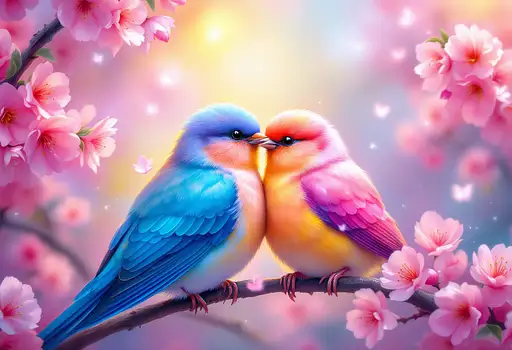
7 months ago
A vibrant painting of two lovebirds cuddling, surrounded by blooming cherry blossoms. The colorful background features soft shades of pink, purple, and yellow, creating a romantic atmosphere. in a vibrant, dreamy visual style characterized by soft pastel gradients that transition seamlessly between pinks, purples, blues, and yellows. Incorporate a luminous, ethereal atmosphere with a subtle glow emanating from focal points. Distribute colors evenly, but emphasize soft highlights and gentle contrasts to create depth. Use delicate, flowing lines and soft textures to enhance the sense of serenity and whimsy. Mix reflective surfaces, translucent elements, and layered compositions to evoke a harmonious balance between light and shadow. Add intricate details with an emphasis on organic patterns and flowing curves to complement the soft, soothing

8 months ago
A stunningly beautiful full-body cybernetic Asian woman with long, sleek black hair flowing in the wind. She has cat-like facial features, mesmerizing almond-shaped eyes, high cheekbones, delicate lips, and flawless luminous skin. Her body is a perfect fusion of organic and synthetic elements, featuring intricate biomechanical details and glowing accents. Her liquid metal biomechanical wings are highly reflective and translucent, flowing like mercury, with glowing iridescent reflections. She stands in a dark cyberpunk cityscape illuminated by neon lights and atmospheric mist. Cinematic lighting, ultra-detailed, hyper-realistic, backlit silhouette, inspired by Katsuhiro Otomo and H.R. Giger, rendered in Unreal Engine 5 and Octane Render.
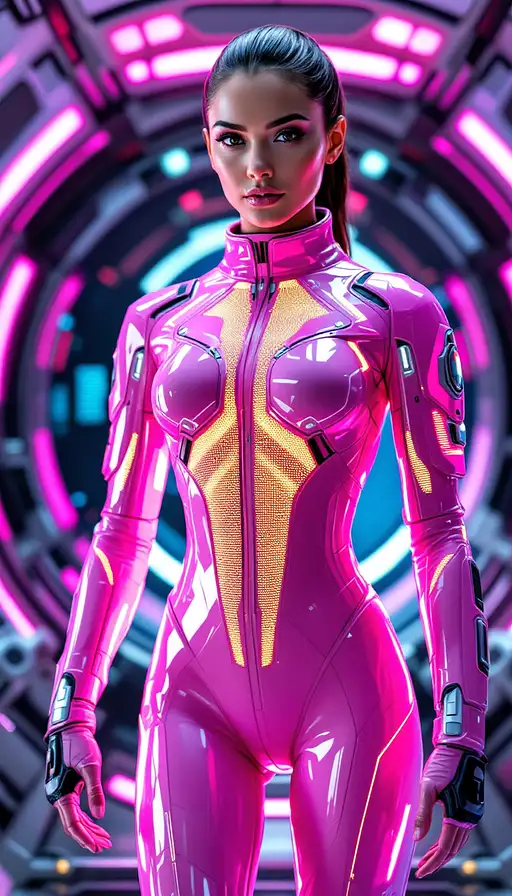
2 months ago
A stunning futuristic depiction of a Mexican female astronaut aboard an advanced spacecraft, wearing a sophisticated body suit with natural realistic body proportions and an innovative neon pink holographic spacesuit. The suit is designed with a futuristic aesthetic, blending cutting-edge technology and elegance. The material features a smooth, translucent digital interface overlay with a subtle holographic sheen, accentuating her athletic and professional physique. The outfit incorporates strategic ventilation panels and ergonomic design elements in the chest and torso areas, engineered for optimal temperature regulation and mobility during extended space missions. The high collar and structured panels give it a space-age appearance, while the ergonomic design emphasizes freedom of movement and functional efficiency. Her left arm features a specialized textured control interface band, resembling a combination of smart fabric and lightweight protective armor, adding technical detail and operational functionality. The advanced materials create an elegant contrast between the holographic suit components and the visible skin areas, giving the outfit a bold and innovative look that remains cohesive within the context of the sci-fi setting. Her confident professional pose, with hands positioned in a relaxed command stance, enhances her authoritative and elegant presence as a skilled space explorer. The background showcases the interior of a high-tech spacecraft, with glowing holographic control panels, intricate quantum machinery, advanced life support systems, and large reinforced observation windows offering a breathtaking view of deep space with distant galaxies and nebulae. Cinematic lighting, photorealistic quality, ultra-detailed textures, professional space photography aesthetic. Negative prompt: cartoon, anime, illustration, painting, drawing, 3d render, deformed, bad anatomy, disfigured, poorly drawn face, mutation, mutated, extra limb, ugly, poorly drawn hands, missing limb, floating limbs, disconnected limbs, malformed hands, blurry, distorted, grainy, low quality, worst quality, text, watermark, signature, unrealistic body proportions, plastic look, glossy skin, disproportionate body, artificial features, exaggerated anatomy.
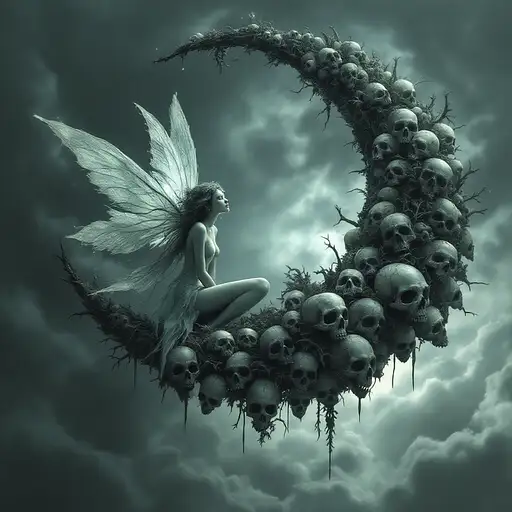
7 months ago
Create a dark fantasy scene featuring a mystical fairy perched on a crescent moon adorned with skulls. The fairy, with delicate, translucent wings, exudes an ethereal glow, contrasting against the ominous backdrop of swirling clouds. The moon should be intricately detailed, with shadows and highlights that enhance its eerie beauty. Capture a sense of enchantment and mystery, blending elements of the macabre with the whimsical.

7 months ago
Photorealistic portrait, surrealist elements, interplay of light and shadow. Close-up view of a Older Black man with African features, dark brown skin, his face partially melting, features dripping like dark, glossy wax. His eyes are a striking, glowing golden-orange, outlined with bright orange eyeliner that extends outward, melting slightly. Dark eyeshadow and glossy, dark pink lips, also exhibiting a melting effect. His hair is styled in dark, thin braids, some strands floating independently. He wears a dark metallic garment with thin, glowing orange and blue lines extending from his face and neck, these lines also exhibiting a melting, surreal quality. Small, metallic components are visible, some floating in the air around his head. The background is a dark gray, with several translucent, light-blue holographic displays floating around his head, containing technical data and schematics, also appearing slightly distorted and melting. The displays contain various symbols, graphs, and alphanumeric characters. Dramatic lighting highlights the melting features and glowing elements, creating a strong contrast between light and dark. The overall style is hyperrealistic with surrealist elements, dark and moody with warm orange and blue accents. High level of detail, polished and professional look. Three-dimensional images created by light beams. 8K

7 months ago
dark fantasy realistic:: cinematic side view:: golden blurred morning background:: ultra-detailed close-up:: tiny enchanted fairy tale scene:: inside a huge ornate lantern:: frozen birch trunk setting:: intricate gothic stone arch entwined with delicate roses:: ethereal fairy with translucent iridescent wings:: glowing neon blue and purple aura:: tiny blooming rosehip bush:: fractal formations of blue neon smoke:: floating neon-lit staircase emerging from the lantern:: soft magical backlight:: octane render quality:: luminous holographic glow:: steampunk elements:: ethereal x-ray effect:: surreal 3D relief texture:: heavy acrylics, resin, and modeling paste adding sculptural depth:: forgotten ancient history aesthetic:: Chinese ink brush painting mystery:: van Gogh swirling brushwork:: vibrant and vivid colors:: deep blues and purples blending into soft golden hues:: neon highlights casting soft shadows:: cinematic ultra-high definition:: mystical steampunk atmosphere:: delicate luminous details:: signature by "Nanzi"
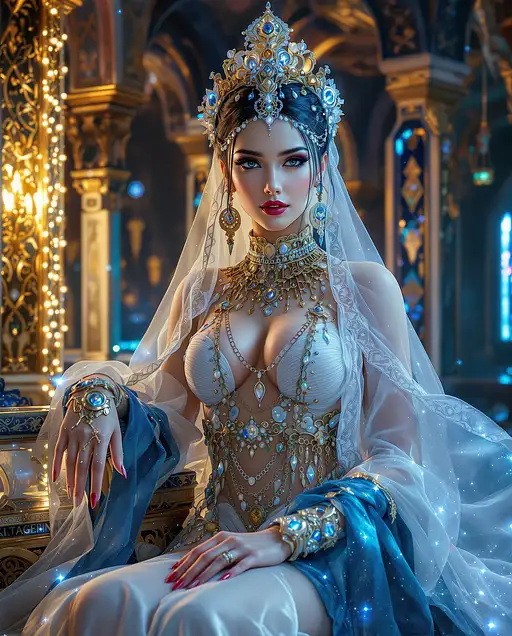
9 months ago
A 19th-century oil painting style ,full portrait depicting an oriental extremely beautiful queen of the harem woman in white and blue revealing silky oriental-inspired clothing. She is adorned with translucent fabrics, metallic veils, and ornate chains that shimmer under ambient lighting. Her look is ethereal, with an abundance of piercings adding to her mysterious allure. The scene is set within an interior combining Persian architectural influences with a futuristic techno space design, featuring intricate patterns, glowing motifs, and surreal magical elements. The atmosphere is awe-inspiring, blending historical opulence with a futuristic mystique.

9 months ago
Full body view of A 19th-century oil painting style ,full portrait depicting an oriental extremely beautiful queen of the harem woman in white and blue revealing silky oriental-inspired clothing. She is adorned with translucent fabrics, metallic veils, and ornate chains that shimmer under ambient lighting. Barefoot. Her look is ethereal, with an abundance of piercings adding to her mysterious allure. The scene is set within an interior combining Persian architectural influences with a futuristic techno space design, featuring intricate patterns, glowing motifs, and surreal magical elements. The atmosphere is awe-inspiring, blending historical opulence with a futuristic mystique.

9 months ago
wet-on-wet splash art ink wash using Bold and Fine fluid brush strokes, soft muted focus and color tones, music album cover art featuring a Dark Phoenix rising from the ashes of a dying sun image, Movie Poster promotional concept artwork, multiple images and layout designs Shabby chic elements full-length front view . Image is a fantasy illustration featuring a woman with extremely long, long, flowing auburn hair and lightly tanned skin, kneeling with her eyes closed. She wears a black, form-fitting outfit with fiery red and orange accents resembling flaming lotus flowers, yin yang, zen ambience,. Behind her, a large, translucent , clear spectral majestic phoenix with vibrant red and orange feathers spreads its wings, creating a dramatic backdrop. The phoenix's wings and the woman's outfit share a similar fiery color palette, emphasizing a connection between them. Surrounding the woman are small, delicate orange flowers, adding a touch of nature to the scene. At the top of the image, the text 'Dark Phoenix Rising' is displayed in a bold, gothic font, colored in black, enhancing the mystical and powerful theme of the artwork. The overall composition is symmetrical, with the phoenix and the woman centrally aligned, creating a balanced and visually striking image. Solid ebony black background The artist's signature "wyldeairt" can be seen written discreetly in a small delicate Parisian cursive script in the bottom righthand corner.

7 months ago
Create a breathtaking and evocative double-exposure oil painting that beautifully captures the profound bond between humanity and nature, using the iconic imagery of Gorillas in the Mist. The painting should focus on the rich emotional depth of the gorillas and the lush, mist-covered landscape of the Congo, blending these elements in a way that symbolizes both the mystery of the jungle and the majesty of these endangered creatures. The central figure of the painting should be a majestic gorilla—painted with intricate detail to reflect the animal’s strength, intelligence, and vulnerability. Its face should be filled with quiet intensity, wisdom, and an almost human-like quality, conveying its deep emotional resonance. The gorilla’s eyes should be the focal point, expressive and full of emotion, perhaps suggesting the struggle for survival, a call for preservation, or an understanding of the delicate balance between nature and human interference. The double-exposure effect should allow the environment to emerge within its form, creating a stunning fusion of the animal and its misty, green habitat. The mist itself should flow through the gorilla’s body and face, creating an ethereal atmosphere that invokes the deep, mysterious quality of the jungle. Soft, translucent layers of paint should be used to capture the wisps of fog, blending into the contours of the gorilla’s powerful form. The mist should not only symbolize the natural environment but also reflect the presence of the unseen—the unseen dangers, the spiritual connection between the gorilla and the jungle, and the ongoing battle to protect these creatures from extinction. Surrounding the gorilla, the dense, vibrant foliage of the rainforest should be depicted in rich, lush greens, with hints of deep browns and subtle touches of vibrant wildflowers. Vines, leaves, and branches can emerge from the mist, merging with the gorilla’s figure, creating the sensation that it is a part of the jungle, and vice versa. The interplay of light and shadow within the leaves and the mist should evoke a sense of both serenity and mystery, with rays of sunlight filtering through the trees, casting soft, glowing highlights on the gorilla’s fur and the surrounding vegetation. The background should suggest both the wildness and fragility of the gorilla’s environment. Darker shades of green and brown can illustrate the dense canopy, while lighter, misty shades should evoke the sense of isolation and vulnerability. In the double-exposure technique, glimpses of the jungle’s wildlife—perhaps a subtle hint of a bird or a distant silhouette of another gorilla—can appear within the mist, symbolizing the delicate interconnectedness of life within the forest ecosystem. The color palette should shift between dark and light—rich earth tones that evoke the depth and complexity of the jungle, paired with the light, airy mist that suggests hope, fragility, and the need for preservation. The mist itself should be painted with fluid brushstrokes that contrast with the more textured rendering of the gorilla, creating a sense of life and motion in both the animal and its environment. This painting should not only represent the beauty and majesty of the gorillas but also serve as a powerful call for conservation. Through the double-exposure technique, it should blur the lines between the animal and its habitat, illustrating the inseparable bond between the two and the urgent need to protect these magnificent creatures from the encroaching threats of human activity. The result should be a masterpiece that blends realism with abstraction, capturing the raw, emotional beauty of the gorillas, the mystique of their environment, and the call for preservation. The viewer should feel immersed in this tranquil yet fragile world, experiencing the emotional weight of the subject matter while marveling at the intricacy and beauty of the painting itself
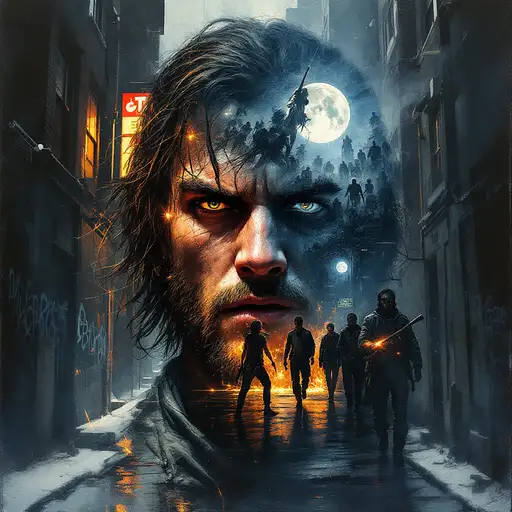
7 months ago
Craft a dynamic and emotionally charged oil painting that uses the double exposure technique to capture the raw energy, unity, and struggles of The Warriors. The central figure should be one of the Warriors, such as Swan, his face half-translucent and fierce, embodying both the individual and collective spirit of the gang. His expression should be filled with determination and defiance, while his figure dissolves into the gritty, chaotic streets of 1970s New York City—dark alleys, graffiti-tagged walls, and the stark silhouettes of neon lights. His features should bleed into the urban landscape, as though he is both a part of the city and a symbol of rebellion against it. Inside his form, a web of interconnected images from the Warriors' journey should emerge: the haunting image of the baseball bat-wielding Rogues, the fire-lit glow of the moonlit escape across subway tunnels, and the strong camaraderie of the Warriors themselves, seen through their shared struggles and brotherhood. The double exposure should seamlessly integrate these elements into his figure, illustrating the tension between individual survival and the unbreakable bond of the gang as they face overwhelming odds together. The color palette should reflect the gritty urban feel of the film, with cool blues, grays, and blacks contrasted with the neon oranges, reds, and greens of the streetlights and graffiti. The atmosphere should feel electric, filled with an undercurrent of danger, defiance, and unspoken loyalty. The oil painting should evoke a sense of movement—like a snapshot of the Warriors running through the night, the harsh cityscape blurring into their form, and the struggle against the forces that threaten to tear them apart. This double exposure composition should not only explore the Warriors' journey through the hostile streets but also the emotional and psychological depth of their fight for survival and unity. The contrast between the rawness of their environment and the bond they share should be at the heart of this painting, encapsulating the spirit of The Warriors as a timeless symbol of resilience and brotherhood.

5 months ago
Create a meticulously staged cinematic scene with rigid symmetry and frontal, low-angle framing, emphasizing a diagonal composition (45-degree tilt) where all elements align along a single dynamic axis. Color Grading: 60% Dominant: Soft, powdery pastel pinks (Pantone 12-1109 TPX "Marshmallow") saturating the sky, snow, and TV casing. 30% Secondary: Frosted teal blues (HEX #6ECEDA) in the glacial lake, aurora, and TV screen static. 10% Accent: Mustard-yellow (Pantone 15-0950 TPX "Golden Glow") in the aurora streaks, wool tufts, and corroded metal knobs. TV Design: A 1950s Bakelite TV (matte eggshell plastic with hairline cracks) tilted diagonally (top-left corner at 10 o’clock, bottom-right submerged at 4 o’clock). Crack: A jagged diagonal fissure (2cm wide) splits the screen from top-left to bottom-right, leaking viscous, neon-bright color bar pigment (RGB values: pink #FF9EB5, teal #5FDAC3, gold #FFD700) that pools into the water below. Materials: Body: Faux-weathered plastic with chipped edges revealing rusted steel underlayers. Details: Three rotary knobs (tarnished brass, 4cm diameter) labeled "VOL," "TUNE," "POWER." Cables: Braided wool cords (undyed cream yarn, 3cm thickness) coiled around the TV’s base, fraying at the ends. Screen Imagery: Static Overlay: A 1953 RCA-style color bar test pattern (8 vertical bands) glitching every 2 seconds, causing the teal and pink bars to "melt" downward into liquid the word "Imagen-4" glitches on the screen Underlying Image: A faint, glowing topographical map (golden-yellow lines on indigo) dissolves into water that cascades from the screen’s crack, merging with the glacial lake. Environment: Glacial Lake: Semi-frozen water (translucent teal, 70% opacity) with jagged ice shards (20cm height) encircling the TV. Snowfall: Heavy, dense snowflakes (1cm diameter) falling at 45 degrees, accumulating on the TV’s top-left corner. Aurora Borealis: Three parallel bands (pink #FFB3D1, teal #7FE5E5, gold #FFE44D) in smooth sine waves, 15° tilt, 80% opacity. Sky: Ultra-high-contrast starfield (ISO 51200 noise pattern) with 2,000 visible stars (randomized 2-4px white dots). Lighting & Effects: Key Light: A frontal, low-orange sodium vapor lamp (3200K) casting sharp diagonal shadows (20° angle) from the TV onto the ice. Bloom: Halation around the aurora and screen, radius 15px, intensity 70%. Textures: Film Grain: 35mm Kodak Vision3 250D overlay (gritty, high-detail). Lens Defects: Two hairline scratches (1px width) at 15° and 75° angles, plus hexagonal lens flare (60% opacity) from the aurora. Physics & Motion: Water: Viscous fluid dynamics—the leaking color bars swirl in 5cm eddies, blending with the glacial lake. Wool: Submerged yarn floats upward in 10cm tufts, swaying at 0.5Hz frequency. Result: A hyper-detailed, reference-free scene that implicitly channels Wes Anderson’s aesthetic through obsessive symmetry, retro-kitsch materials, and a strict 60/30/10 pastel hierarchy—no director named, all style embedded in granular technical specs.

5 months ago
"Create a meticulously staged cinematic scene with rigid symmetry and frontal, low-angle framing, emphasizing a diagonal composition (45-degree tilt) where all elements align along a single dynamic axis. Color Grading: 60% Dominant: Soft, powdery pastel pinks (Pantone 12-1109 TPX "Marshmallow") saturating the sky, snow, and TV casing. 30% Secondary: Frosted teal blues (HEX #6ECEDA) in the glacial lake, aurora, and TV screen static. 10% Accent: Mustard-yellow (Pantone 15-0950 TPX "Golden Glow") in the aurora streaks, wool tufts, and corroded metal knobs. TV Design: A 1950s Bakelite TV (matte eggshell plastic with hairline cracks) tilted diagonally (top-left corner at 10 o’clock, bottom-right submerged at 4 o’clock). Crack: A jagged diagonal fissure (2cm wide) splits the screen from top-left to bottom-right, leaking viscous, neon-bright color bar pigment (RGB values: pink #FF9EB5, teal #5FDAC3, gold #FFD700) that pools into the water below. Materials: Body: Faux-weathered plastic with chipped edges revealing rusted steel underlayers. Details: Three rotary knobs (tarnished brass, 4cm diameter) labeled "VOL," "TUNE," "POWER." Cables: Braided wool cords (undyed cream yarn, 3cm thickness) coiled around the TV’s base, fraying at the ends. Screen Imagery: Static Overlay: A 1953 RCA-style color bar test pattern (8 vertical bands) glitching every 2 seconds, causing the teal and pink bars to "melt" downward into liquid with the word "Prompthero" barely visible on it. Underlying Image: A faint, glowing topographical map (golden-yellow lines on indigo) dissolves into water that cascades from the screen’s crack, merging with the glacial lake. Environment: Glacial Lake: Semi-frozen water (translucent teal, 70% opacity) with jagged ice shards (20cm height) encircling the TV. Snowfall: Heavy, dense snowflakes (1cm diameter) falling at 45 degrees, accumulating on the TV’s top-left corner. Aurora Borealis: Three parallel bands (pink #FFB3D1, teal #7FE5E5, gold #FFE44D) in smooth sine waves, 15° tilt, 80% opacity. Sky: Ultra-high-contrast starfield (ISO 51200 noise pattern) with 2,000 visible stars (randomized 2-4px white dots). Lighting & Effects: Key Light: A frontal, low-orange sodium vapor lamp (3200K) casting sharp diagonal shadows (20° angle) from the TV onto the ice. Bloom: Halation around the aurora and screen, radius 15px, intensity 70%. Textures: Film Grain: 35mm Kodak Vision3 250D overlay (gritty, high-detail). Lens Defects: Two hairline scratches (1px width) at 15° and 75° angles, plus hexagonal lens flare (60% opacity) from the aurora. Physics & Motion: Water: Viscous fluid dynamics—the leaking color bars swirl in 5cm eddies, blending with the glacial lake. Wool: Submerged yarn floats upward in 10cm tufts, swaying at 0.5Hz frequency. Result: A hyper-detailed, reference-free scene that implicitly channels Wes Anderson’s aesthetic through obsessive symmetry, retro-kitsch materials, and a strict 60/30/10 pastel hierarchy—no director named, all style embedded in granular technical specs.
